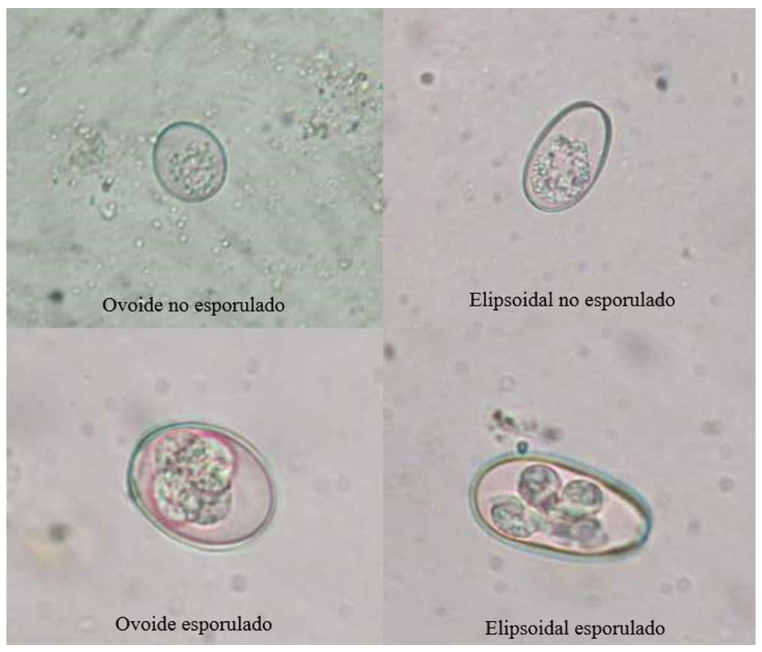Protozoa (Sporozoasida: Coccidiasina) in pet dogs from Cajamarca city, northern Peru
Main Article Content
Abstract
This study aimed to determine the prevalence and describe the morphometric characteristics of coccidia found in pet dogs from Cajamarca city. Fecal samples were collected from 196 dogs and analyzed by the Faust method. The prevalence of animals with coccidia was 27.04 % (95 % CI: 20.82 - 33.26), with 8.67 % (95 % CI: 4.73 - 12.61) corresponding to Eimeria spp., 16.33 % (95% CI: 11.13 - 21.53) to Cystoisospora spp., and 2.04 % (95% CI: 0.06 - 4.02) to Sarcocystis spp. Eimeria spp. oocysts were one- or two-layered walls, yellow-green in color, and ovoid (21.32 ± 4.34 × 17.49 ± 4.13 µm) and ellipsoidal (28.00 ± 2.69 × 18.39 ± 2.24 µm) shapes. Cystoisospora spp. oocysts exhibited a single-layered wall, yellow-green in color, and ovoid (38.73 ± 4.16 × 31.92 ± 2.56 µm) and subspherical (37.98 ± 3.64 × 34.79 ± 3.21 µm) shapes. Meanwhile, the sporocysts of Sarcocystis spp. contained four sporozoites, with a granular residual body at one of their poles. The sporocysts measured 14.16 ± 0.88 × 9.15 ± 0.81 µm. The presence of coccidia in pet dogs from Cajamarca city underscores the importance of simple recognition of at least the parasitic genus for its targeted prevention and treatment.
Article Details

This work is licensed under a Creative Commons Attribution-NonCommercial 4.0 International License.
National Center for Animal and Plant Health (CENSA)References
McDowall S, Hazel SJ, Cobb M, Hamilton-Bruce A. Understanding the Role of Therapy Dogs in Human Health Promotion. International Journal of Environmental Research and Public Health. 2023;20(10): 5801. https://doi.org/10.3390/ijerph20105801.
Miller AD. Histopathologic diagnosis. In: Bowman D (ed.) Georgis’ Parasitology for Veterinarians. 11th ed. Elsevier; 2021. p. 455-478.e1. https://doi.org/10.1016/B978-0-323-54396-5.00017-9. [Accessed 8th November 2024].
Dubey JP, Lindsay DS. Coccidiosis in dogs-100 years of progress. Veterinary Parasitology. 2019;266: 34-55. https://doi.org/10.1016/j.vetpar.2018.12.004.
Noack S, Chapman HD, Selzer PM. Anticoccidial drugs of the livestock industry. Parasitology Research. 2019;118(7): 2009-2026. https://doi.org/10.1007/s00436-019-06343-5.
Muthamilselvan T, Kuo TF, Wu YC, Yang WC. Herbal Remedies for Coccidiosis Control: A Review of Plants, Compounds, and Anticoccidial Actions. Jeong SI (ed.) Evidence-Based Complementary and Alternative Medicine. 2016;2016(1). https://doi.org/10.1155/2016/2657981.
Colella V, Wongnak P, Tsai YL, Nguyen VL, Tan DY, Tong KBY, et al. Human social conditions predict the risk of exposure to zoonotic parasites in companion animals in East and Southeast Asia. Communications Medicine. 2022;2(1): 144. https://doi.org/10.1038/s43856-022-00210-8.
Yu Z, Ruan Y, Zhou M, Chen S, Zhang Y, Wang L, et al. Prevalence of intestinal parasites in companion dogs with diarrhea in Beijing, China, and genetic characteristics of Giardia and Cryptosporidium species. Parasitology Research. 2018;117(1): 35-43. https://doi.org/10.1007/s00436-017-5631-7.
Bacilio-Gutiérrez D, Torrel-Pajares TS, Vargas-Rocha LA, Rojas-Moncada J. Coproprevalencia de Cystoisospora spp. en canes domésticos (Canis lupus familiaris) del distrito de Cajamarca, Perú. Revista Veterinaria. 2023;34(1): 14. https://doi.org/10.30972/vet.3416605.
Faust EC, D’Antoni JS, Odom V, Miller MJ, Peres C, Sawitz W, et al. A Critical Study of Clinical Laboratory Technics for the Diagnosis of Protozoan Cysts and Helminth Eggs in Feces. The American Journal of Tropical Medicine. 1938;s1-18(2): 169-183. https://doi.org/10.4269/ajtmh.1938.s1-18.169.
Dubey JP, Calero-Bernal R, Rosenthal BM, Speer CA, Fayer R. Sarcocystosis of Animals and Humans.. 2nd ed. Sarcocystosis of Animals and Humans, Second Edition. Boca Raton: CRC Press; 2015. https://doi.org/10.1201/b19184. [Accessed 8th November 2024].
Torrel TS, Vargas LA, Murga CA, Huaman V. Prevalencia de Eimeria sp y estudio morfométrico de ooquistes hallados en canes domésticos de Perú. Revista Veterinaria. 2022;33(1): 59. https://doi.org/10.30972/vet.3315882.
Ydrogo M, Cabrera M, Cuzcano-Anarcaya JL, Vargas-Rocha L, Torrel T. Evaluation of the presence of Sarcocystis spp. in dogs raised in alpaca farm enterprises in Cajamarca, Peru. The Thai Journal of Veterinary Medicine. 2024;54(4): 1-6. https://doi.org/10.56808/2985-1130.3632.
Lee Y, Lu M, Lillehoj HS. Coccidiosis: Recent Progress in Host Immunity and Alternatives to Antibiotic Strategies. Vaccines. 2022;10(2): 215. https://doi.org/10.3390/vaccines10020215.
Esch KJ, Petersen CA. Transmission and Epidemiology of Zoonotic Protozoal Diseases of Companion Animals. Clinical Microbiology Reviews. 2013;26(1): 58-85. https://doi.org/10.1128/CMR.00067-12.
